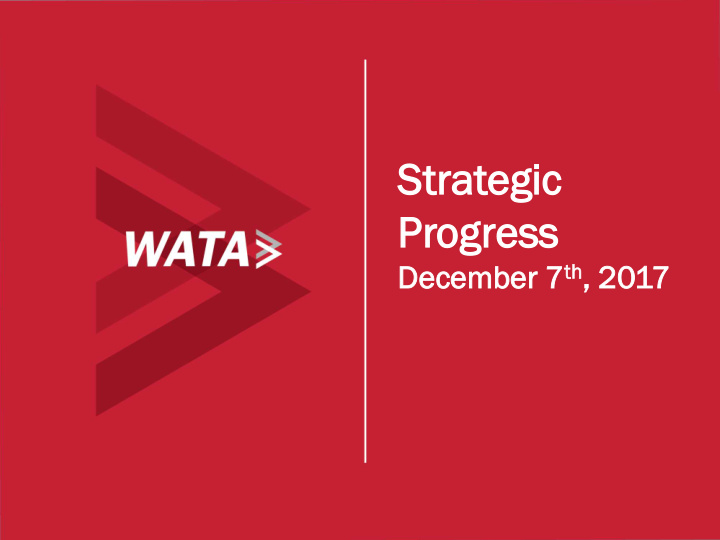



Strat trategic gic Pr Progress ogress December cember 7 th th , , 2017
Statistics • How many stops, routes, and areas does WATA currently service? – ~300 unique stops, 12 individual routes across several areas to include, James City County, Williamsburg, Surry, York County, and Newport News • What kind of assets are currently offered and in use throughout the areas serviced? – 38 stops have a shelter, while 58 have trash cans. This does not count amenities we are not responsible for. • Where do we fall short? – 7- 23 of the 2015 TDP defines an improvement project needing a “full bus stop inventory and analysis”. Data driven decision making remains a sore spot for planning. –
WATA Through the Ages
TDP Recommended Changes • About 30 changes were recommended, all but 4 were implemented. – Routes haven’t significantly changes over the course of WATA’s history – More development is occurring further out, stretching the running time limits of the routes • Most of the remaining changes deal with more esoteric route options such as interlining or increasing the service frequency • Changes have been generally accepted as positive by customers due to better on-time performance – Most of the route changes were for on-time performance and to reduce the strain on the drivers as the routes didn’t allow for breaks
Stop Analysis • Using the web-based program Airtable to create a database for our stops and amenities • Tracking items such as: Amenities – – Stop Category – Routes Serviced – X and Y Coordinates – Stop numbers – Amenities- Date purchased – Amenities- funding source • Introducing a classification system for bus stops to help create a system wide set of standards.
Stop Analysis • By the end of calendar year 2017 we will be proposing a motion to the board to approve a series of regulations in regards to WATA stop amenities. Tables 5-2 and 5-3 from the • TDP have provided data to aid in the creation of a classification system that will be applied to all stops within the system, and will aid in the evaluation of potential future sites.
System-Wide Guidelines The next set of guidelines • will include reference to the following: – Bus Stop Spacing – Acceptable length and conditions for a pull-off – Considerations for near side vs far side stops Considerations for urban vs. rural – areas – Different types of pull-off options • Once this section is completed WATA will have the groundwork for justification of every choice for amenities or stop locations. • This can then be distributed to assist with permitting and design.
Software and Hardware • RouteMatch has been implemented for our paratransit operations – It is simplified the work for operators and dispatchers as well as ensuring that we are not missing customer trips and info – It will eventually be integrated with the One- Call Center’s RouteMatch database – New phone system simplified paratransit customer calls reducing call volume for staff – ADA trips have roughly doubled in the last three years – Expanded routes such as Jamestown and Lackey have increased our service area • Interactive Planning Platforms – WATA has been looking at several interactive planning platforms such as Remix – This would allow staff to quickly evaluate proposals and respond to requests from customers and localities as well as help WATA to make informed decisions regarding the effects of route changes on customers • Automatic Passenger Counters to help implement better data driven planning functions • Review and modernization of our Automatic Vehicle Locator system to bring it up to modern standards and reduce the back-office tasks that are required of staff to implement changes
Upcoming Activities • WATA will be transitioning away from a color based naming convention for its routes to a number based one – This process will occur gradually over the next several months, with a full transition in July 2018 • WATA is examining a comprehensive route redesign study which may occur in the next couple of years. This would allow WATA to “start from the ground up” and examine all of our routes to ensure that they are the best designed for WATA. • Increasing focus on facilities such as a new Operations and Maintenance Facility, a Northside Transfer Facility (tentatively located on Opportunity Way), and examining the redevelopment of the transfer point for WATA and HRT located at Lee Hall
Recommend
More recommend